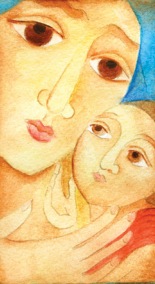
In my last post, I wrote about Bach’s brilliant Cantata No. 40. If we imagined ourselves in the pews on the second day of Christmas in Leipzig with that piece, for the next piece on the program, we must journey to late seventeenth century France for Midnight Mass on Christmas Eve (not at all a bad journey to make!). This piece has long held my imagination, and perhaps I’m taken by its programatic intent: for a liturgical musician to imagine a French cathedral at midnight on Christmas Eve, perhaps a light dusting of snow in the churchyard, the congregation bathed in the glow of soft candlelight, incense aplenty, and the ever-so-elegant sonorities of French baroque instrumentalists and singers, playing and singing this highly ornamented and beautiful music, is a kind of ecclesiastical Eden.
Generally speaking, large choirs and modern orchestras don’t assay this music all that often – it’s much easier to imagine a few singers on a part, and a smattering of string players, a couple of flutes and continuo. If there is a larger choir up to the challenges of rendering this music with style and precision, we’re surely contenders – we’ve made a specialty of singing the intricate counterpoint of Bach’s music with precision and clarity for over a century! Likewise, among our number in the Bach Festival Orchestra are several early French music specialists, who will bring their knowledge to bear in our interpretation. So, this Mass doesn’t contain the kind of musical fireworks and taunting of the devil found in Cantata No. 40, but, rather, all of the elegance and panache of a Fabergé egg: deeply ornamented, intricate, and astonishingly beautiful. In our singing, we’ve been working on pinpoint clarity and a great deal of color, but with the sound picture of a chamber choir and orchestra.
Charpentier was a very prolific composer, frequently overshadowed by Jean-Baptiste Lully (who was equally famous for the control he exerted over the Parisian musical scene of his time, as for his unfortunate end: Lully conducted with a large staff, and during a particularly rousing performance, he struck his toe, and the resulting wound became infected and caused his death in 1687). Like Bach, Charpentier was little-published in his lifetime, though greatly regarded by his contemporaries. His music has had something of a revival in recent years, and I commend the particularly pioneering work of American conductor and harpsichordist William Christie and his French period instruments group, Les Arts Florissants, to listeners interested in exploring this intriguing repertoire.
Charpentier’s Messe de Minuit pour Nöel or “Midnight Mass for Christmas,” makes ingenius use of popular Nöels or Christmas carols of his time. This is a practice we might expect of Martin Luther, whose reimaginings of secular songs into sacred contexts are legion and infamous, but it was also in use elsewhere on the continent. These carols were routinely arranged by French Classic organists (a frequent back-door through which many folk songs found their way into liturgical spaces – indeed, Charpentier instructs the organist to play one of the carols in the midst of the Kyrie), and by the time Charpentier composed the Mass, the carols would have been known well by congregations assembled for the Christmas Eve liturgy.
Listening to the music, itself, one is struck by Charpentier’s brilliance in reworking these carols into pieces purposed for liturgy. There is certainly an earthy, rustic quality to the music, but Charpentier applies the refiner’s fire to the carols, and they emerge with a remarkable fusion of the sacred and the temporal. Listeners will note the dotted rhythms and the notes inégales (a kind of French baroque swung eighth note). This is highly ornamented (with ornaments often improvised by the instrumentalists) music, and Charpentier makes frequent use of text painting to evoke the meaning of the words as he sets them. In the Gloria, the et in terra pax (“and on earth, peace to humankind”) affects a beautiful yearning for peace, followed by the buoyancy of a celebratory laudamus te (“we praise thee”). This music frequently shifts rhythmic gears, tempo and texture, which allows Charpentier the flexibility to be quite specific in his text-painting. You will also hear a slightly Italian influence in this music, as Charpentier spent a few years in Rome as a student of Giacomo Carissimi – I hear slight echoes of renaissance polyphony in the more contrapuntal sections of his music, as well as a slight whiff of Monteverdi. As such, one might think of Bach and Charpentier as fellow travelers, who both incorporated a wide range of influences in their music, though in ways that differ in terms of compositional practices. The Mass clocks in at a little over thirty minutes, and I think our audience will find much to appreciate in this gorgeous music. As I mentioned at the outset, it is tremendously evocative, and it’s a particular joy to imagine the places to which this music will take both performers and audience, alike.
My next post will explore four similarly evocative pieces, the Motets for the time of Christmas by twentieth century master, Francis Poulenc. They are for unaccompanied choir, and will demonstrate The Choir’s increasing ardor and skill for a capella repertoire.










































